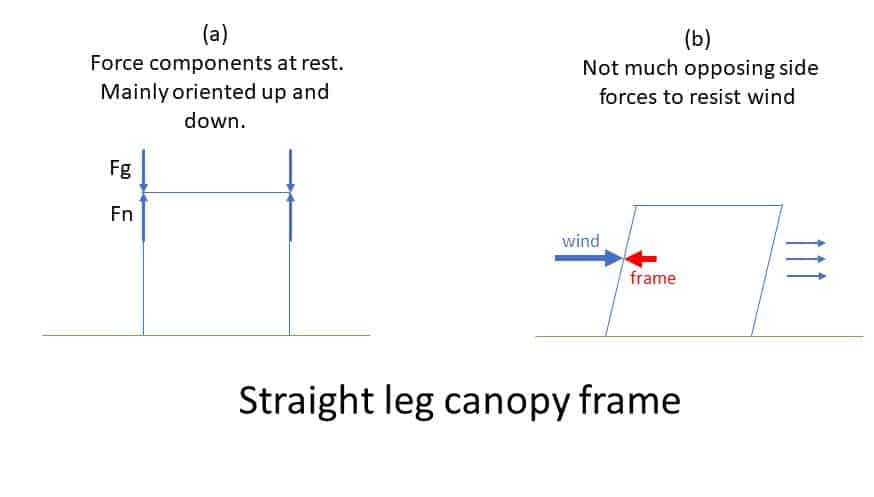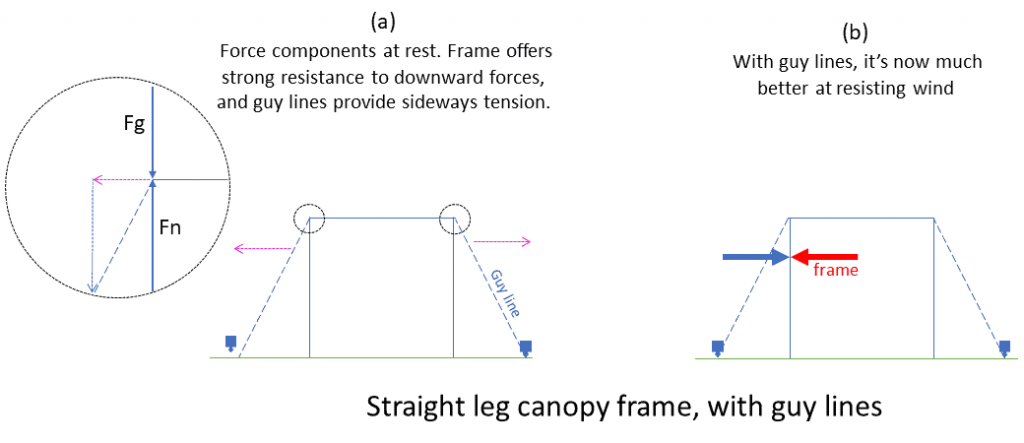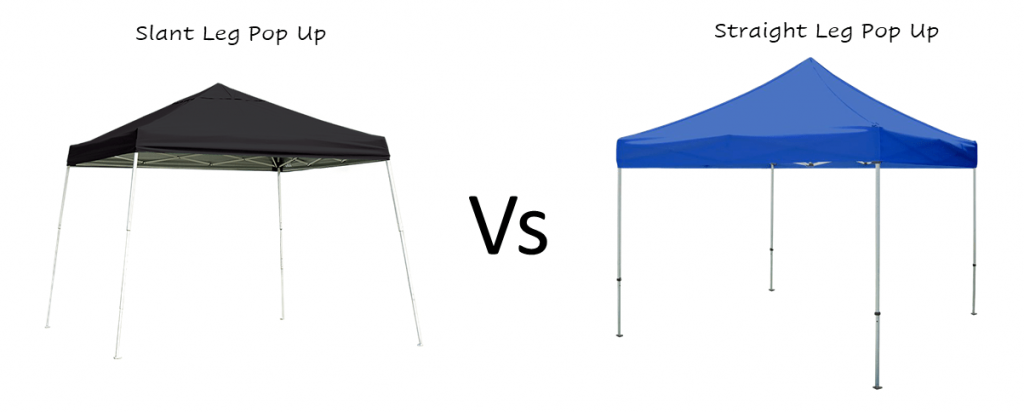The name ‘slant’ and ‘straight’ leg canopy refer to the angle at which the upright corner poles of a pop up canopy are aligned (also called instant up). As the term suggests, straight leg designs have legs that are perpendicular or 90 degrees to the ground, and slant legs are at some angle to it.
In this article I aim to clarify the different use cases for a slant leg vs straight leg canopy. I believe for most people and situations a straight leg canopy that is secured with ropes or weights will be better than a secured slant leg canopy. If you want the long detailed answer…it depends on where/how you’re using it. I’ll first summarize what I consider to be the main differences, and then you can read on if you want a deeper explanation.
Overview of slant vs straight leg
| Feature | Slant Leg | Straight Leg |
| Structural strength | Better at resisting forces pushing side-on (e.g. wind) | Better at resisting forces pushing down (e.g. rain, hanging heavy objects off the frame, holding up heavy canopy tops). However, if you secure the corners with guy lines, you also get the additional side resistance that the slant leg canopy gives you. |
| Shade area | Less shade area (compared to a straight leg of the same ground footprint) | Optimal shade area (compared to slant leg of the same ground footprint) |
| Setup area | Less efficient with space when in a canopy/tent crowded area | No wasted room when setup next to other canopies/tents |
| Frame material quality | There are good/bad brands around, however they are generally built to be lighter, which typically means less robust. | Has to be built strong to maintain its shape, and therefore the materials themselves tend to be more robust (and typically more heavy than a slant leg canopy). However there are always good and bad exceptions. |
Canopy frame strength
So first please let the record hold that I am not a mathematician/physicist (hard enough time spelling those words), so this is a rudimentary analysis. Feel free to provide some critical feedback. Hopefully it’s enough in the right direction to provide some value.
When attempting to analyse the forces of any system it’s important to keep in mind your frame of reference (pun intended), or in other words – isolate what you are trying to measure. There is no one optimal structural design for every situation.
Let’s start by thinking about some of the basic forces that are important to consider for general canopy use. One of these would be wind, which can act in all directions but the one we are mainly worried about is the direction that will blow our canopy over; or up and over. Wind pressing down is only helping keep our canopy down. The other forces are those that are pressing it down into the ground like it’s weight, and inclement weather like heavy rain or snow.
So how do slant and straight leg canopies respond to wind, and hold up against it’s weight?
How frame design affects performance
Continuing my oversimplification of the real world, let’s assume that the wind force is impacting the frame from the side only. If the frame is still standing it must be resisting the incoming force imposed by the wind, and it will continue to do so unless the wind force becomes too much and it buckles. Note here that I’m referring to the structural strength of the frame, not so much how much wind is needed for it to fly off in the wind; that’s more impacted by the weight of the canopy and the canopy top material.
A slant frame is stronger against wind originating side-on, as the angled legs are providing some opposing normal force (see Figure 1).

A straight leg canopy (of same weight) has a smaller sideways force component than the slant leg, and is therefore not as structurally strong against wind in this direction (Figure 2). However if we change what force we are imposing to something pulling the frame downwards (eg. heavy canopy material, hanging craft market items off frame), it’s not a great leap to suggest that straight leg canopies can resist more vertical pulling forces than a slant leg canopy of similar weight (Figure 2(a)).

When comparing two different canopy shapes you need to be aware that the manufacturer may have taken the opportunity to use lighter and less robust components in the slant leg canopy, precisely because it can put up with a bit more wind. So any gains in strength by having a slant leg design, may have been squandered away by having lesser quality components that will break much easier. A straight leg frame must be built sturdier to maintain its shape. If you are looking for a light beach pop up canopy then a slant leg design might be a good option.
However, if you don’t need a super light option and want something more sturdy, you can augment a straight leg canopy setup by adding guy lines. This provides some additional sideways tension, which means you get the best of both worlds. It also helps stop your canopy from taking off in a gust of wind.

Shade and footprint
The are other considerations too with purchasing a straight vs slant leg canopy:
- You can fit other canopies around it easily, which is necessary for crowded places like markets. When trying to place two angled leg canopies next to each other there will be some wasted space, which isn’t ideal where real estate is at a premium.

Photo by Lisheng Chang on Unsplash.
- With a straight leg canopy, the square footprint of the base of the canopy matches the canopy top material area, which means you maximise the possible shade cover. In a slant leg design, the roof is more narrow than the base, which means you lose some shade. This is another reason you have to be careful with direct comparisons of slant and straight canopies.
Conclusion
At the end of the day as long as you weight/tie down your canopy, most people won’t notice the difference between a straight leg vs slant leg canopy when using in fair conditions. Slant frame canopies have an inherent structural resistance that helps them oppose wind from the side, however this is often negated by opportunistic manufacturers that make them as light (and therefore in most cases as weak) as possible.
The best solution in my view is to pair the overall weightbearing strengths of a straight leg canopy (good for heavier canopy tops or hanging objects off the frame) with some ropes to secure it down, giving it some side wind resistance (here are some tips on how to setup a canopy). A straight leg canopy also maximises the shade area, and makes more sense when placed near other pop up canopies.

